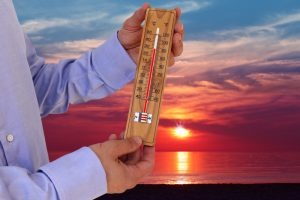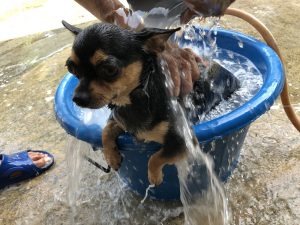Heatstroke and Other Heat-Related Conditions
It’s summer and in many parts of the Northern Hemisphere that means higher temperatures and the possibility of hyperthermia – better known as heat-induced illnesses. There are four conditions that make up these heat-related and heat-induced illnesses and if you listened to my podcast you already know what they are. But for those who missed the podcast I describe them again below.
Heat Cramps
These are the first sign that you should get out of the heat and humidity and especially out of the sun. Heat (muscle) cramps occur in legs, arms, and even in your abdomen. They happen after strenuous activity in the heat or when you are dehydrated. You may think that you pulled a muscle and can’t remember where or when it might have happened. At that point, stop and realize that it’s not a muscle pull or the result of any kind of activity – you need water and some electrolytes would be good as well.
Heat Syncope (better known as fainting)
This happens when your body is trying to cool itself off by sweating, your blood vessels dilate which reduces the flow of blood to the brain. And then you feel faint or actually do faint. Be very careful because this could happen anywhere and you could get hurt if you fall onto or into something. And please pull over if you are driving when it starts to happen.
It can also occur if you’ve been in the heat and sun and you try to get up too quickly or have been standing for a long time. Fatigue and thirst also go along with this condition.
Heat Exhaustion
When your body temperature starts to rise you are moving into Heat Exhaustion. Your breathing and pulse may be rapid and you will start to feel ill with some of the following symptoms:
- heavy sweating
- weakness
- headache
- cold, pale, and clammy skin
- nausea
- dizziness
- blurred vision
- vomiting
If you don’t get treatment for Heat Exhaustion then it may lead to Heatstroke the most dangerous of the four conditions.
Heatstroke
First off, Heatstroke is a medical emergency. Once you have it you need to get to a medical facility as quickly as possible.
In the US alone more than 600 deaths a year occur from extreme natural heat exposure and 20% of Heatstroke victims suffer long term, irreversible brain damage. If you are older than 65, have an illness or disease, or take some medications and the weather is over 95 degrees you have a higher chance of developing Heatstroke. This is due to their bodies not sensing and responding fast enough to overheating.
Heatstroke can lead to organ failure, brain damage, and death. It comes on very quickly and becomes life-threatening within minutes.
There are 2 kinds of Heatstroke – Classic and Exertional. Classic is what happens during heat waves and especially when there is high humidity along with it. It is also the type that people over 70 with other medical conditions and on medications experience.
Exertional usually affects younger, more active people who are participating in athletic events or are exercising on their own. Exertional Heatstroke sometimes won’t come on until hours after the activity finishes. Exercising in the heat overtaxes the body and it can’t cool itself down because its temperature control system is malfunctioning.
Heatstroke Symptoms
Any one or combination of the following symptoms will occur with Heatstroke:
- Hot dry skin (Classic)
- Hot sweaty skin (Exertional)
- Rapid and strong pulse
- Rapid and/or shallow breathing
- Confusion
- Disorientation
- Fatigue
- Severe headache
- Nausea and vomiting
- Muscle cramps and/or weakness
- Dark-colored urine
- Delirium
- Seizures
- Staggering
- Agitation or combativeness
- Loss of consciousness
- Dizziness and/or fainting
Prevention
When it’s hot and humid drink a lot of water – if you’re thirsty then you’re not drinking enough. Keep a glass of water near you and sip from it all day long. Drinking some water with electrolytes can also help you to keep your energy up when it gets hot.
If you don’t have air conditioning then go to some place that does. Like shopping malls, supermarkets, movie theaters, restaurants, sports arenas, libraries, and community centers. Just being in air conditioning for the hottest part of the day will reduce your risk of hypothermia.
In your home, keep the shades drawn during the day, use fans, and open the windows at night to let in the cooler air. Go out to run errands or exercise early in the day before the heat and humidity get bad or in the evening after the sun has gone down.
Avoid alcohol, sugary drinks, and caffeine. Wear loose-fitting lightweight garments that are light-colored and preferably made from cotton.
And here’s one that I didn’t know before – take tepid temperature baths and showers to cool the body down. Turns out that water conducts heat away from the body so baths and showers are one of the best body coolers available.
Have a discussion with your doctor before the summer heat starts about any medications you’re taking and or any physical issues you have. Find out if any of your issues or medicine can be a problem when the weather heats up and what to do about it.
What To Do For Hyperthermia
If a person has Heatstroke or hyperthermia along with some underlying condition (like a heart disorder) then the first thing you should do is call 9-1-1 for emergency help.
For heat cramps, syncope (fainting), or exhaustion then first make sure they are out of the sun and heat and in some place that’s cooler or air-conditioned. Get them to lie down with their legs up. Ask them to drink some cool (not cold) water, preferably with some electrolytes in it.
Suggest they take a shower or bath with cool water or at least sponge off with cool water. You can also spray them with some water and have them sit in front of fan to cool off. Try applying a cold compress or cool towels to the back of the neck, armpits and groin to help them cool down.
If none of these help within 30 minutes then call 9-1-1.
Your Pets Can Also Get Heatstroke
Don’t forget that most of this information applies to your pets as well and that they are much more vulnerable than the rest of us. Give them extra water, keep them in a cool place, and if they start to overheat spray them with the hose to cool them down. If none of that works then take them to the vet or pet hospital immediately for treatment.
Summary
Heat and humidity are very dangerous when they both go up into the higher numbers. Be sure to stay well hydrated, out of the sun, and in a cool place. Only exercise when it’s cooler out or in an air-conditioned gym.
And if you or someone you know starts exhibiting any of these symptoms get them out of the sun, into a cooler place, and then try to ascertain how serious their symptoms are. If it’s serious or you know that they have some kind of medical condition that would automatically make it serious call 9-1-1 immediately. Better to be safe than sorry.
Be sure to listen to my earlier podcast on Heatstroke too!